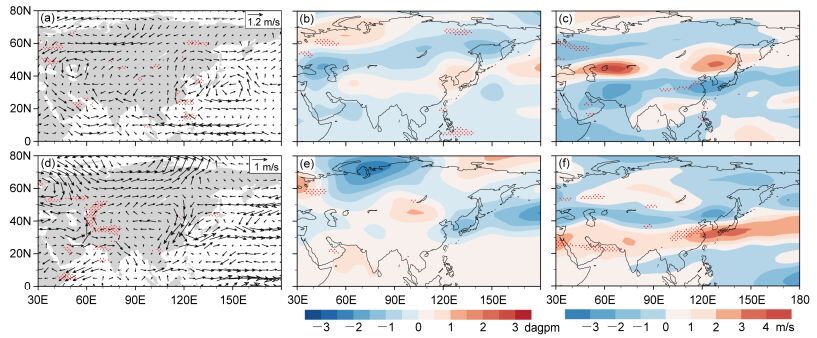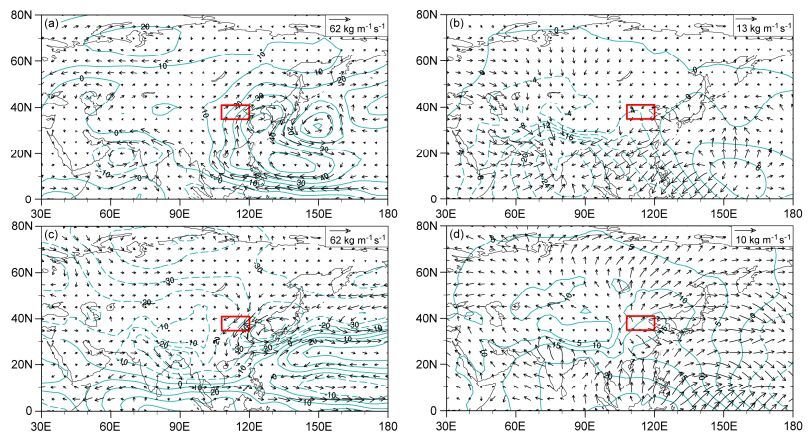2 河南省气象台, 郑州 450003
2 Henan Meteorological Observatory, Zhengzhou 450003
在全球变暖的背景下,气象灾害的时空分布特征发生了显著的变化,大范围高温热浪和雨雪冰冻等极端灾害性天气更加频发,极端气候灾害造成的损失越来越严重(赵俊虎等,2015)。在我国由于极端天气气候事件引起的气象灾害占整个自然灾害的70%左右(翟盘茂等,2007),极端降水事件虽然是一种小概率事件,近年来极端降水事件频发,对社会经济及生态系统造成的危害受到越来越多的关注(翟盘茂和章国材,2004)。在全球变暖背景下,总降水量增大的区域,极强降水量有可能以更大的比例增加,即使平均总降水量减少的地区,强降水量极其降水频数也有可能增加(IPCC,2001;柯丹和管兆勇,2014)。研究表明,日本最大1 d降水量、最大5 d降水量和湿日数呈现增加的趋势(Duan et al., 2015),印度的极端高降水量和极端低降水量均有不同程度的增加(Jun et al., 2015),美国西部区域超过50%测站的每年最大极端降水值主要发生在2月和7月(Bracken et al., 2015)。Alexander et al.(2006)认为,全球降水的极值分布在空间上缺乏一直性,对我国而言,不同季节的极端降水事件表现出显著的差异(Wang and Zhou, 2005;陈海山等,2009),并且其变化具有明显的区域性特征,我国降水主要集中在夏季,多位学者的研究发现我国年极端降水事件与年总降水之间有很好的相关性(Wang and Zhou, 2005;Zhai et al., 2005;杨金虎等,2008)。我国西北地区(董蕾等,2014)、长江中下游地区(Zhang et al., 2015)和南方地区(任正果等,2014;Zhang et al., 2015)的极端降水事件呈现增加趋势,华北地区的极端降水事件呈现减少趋势(翟盘茂和潘晓华,2003),Dong et al.(2011)的研究表明1951~2000年我国215个测站的极端降水趋势的空间分布,发现淮河流域上游发生极端降水事件的概率大,柯丹和管兆勇(2014)研究表明华中地区夏季极端降水事件在20世纪80年代开始偏多。
有关我国极端降水事件成因的研究,前人已有一些研究。李威和翟盘茂(2009)、杨金虎等(2008)通过分析太平洋海表面温度异常同我国东部和长江中下游之间的关系表明,前赤道中东太平洋为影响我国夏季极端降水的关键区。Mao et al.(2011)研究北极涛动与中国中东部地区的冬季极端降水表明,北极涛动在冬季1~2月与我国中东地区的极端降水的频率成显著的正相关关系。Zhang et al.(2015)研究我国东南沿海的冬季极端降水事件与海表温度异常,发现当印度洋海温和太平海温处于不同的位相时,对我国东南沿海地区的极端降水事件将产生不同的影响。因此,对于我国极端降水物理机制的研究有待我们进一步深入的了解。
有研究表明(施能等,2003;IPCC,2007),全球陆地年降水量具有明显的趋势变化特征,在30°N~85°N的很多区域有明显增加,在低纬地区降水减少,我国东部处于亚洲季风区,对灾害性事件的敏感性较强,人口聚居,经济发展快速,极端降水事件对其更易造成较大的危害,因此研究东部极端降水事件的及分析其环境背景场具有重要的理论意义。本文主要利用1961~2014年中国东部地区的438的台站资料,从大气环流角度分析不同极端降水频次下的环境场及水汽输送,同时也从能量角度简单分析了有利于极端降水事件发生的能量分布。
2 资料和方法 2.1 资料本文所定义的中国东部为105°E以东的地区,采用的降水资料是中国气象局国家气象信息中心经过均一化处理的有连续降水记录的1961~2014年的438个台站的逐日降水资料,其中均一化检验及订正的方法参考杨溯和李庆祥(2014)。本文的大气环流资料来自美国国家环境预报中心和美国国家大气研究中心(NCEP/NCAR)逐月再分析资料风场、气压场、比湿场等(Kalnay et al., 1996),关注的时间均为1961~2014年,水平分辨率为2.5°(纬度)×2.5°(经度)。
2.2 方法根据翟盘茂和潘晓华(2003)对极端降水事件的定义和Bonsal et al.(2001)提出的计算方法,分别计算每个站各自的阈值。具体做法是:将某站1961~2014年逐年夏季湿日降水量序列的第95个百分位值的54 a平均值作为该站极端降水事件的阈值,当该站某日降水量超过这一阈值时,则记为一次极端降水事件。其中,极端降水强度的定义为极端降水强降水量与极端降水日数的比值。本文主要根据此定义的极端降水事件,讨论极端降水频次的变化及不同情况下的大气环流。
为了分析中高纬的阻塞高压的活动特征,本文采用Tibaldi and Molteni(1990)提出的阻塞识别方法(简称TM90),TM90阻塞识别方法使用逐日的500 hPa高度场资料沿纬圈分别计算:
| ${G_{\rm{S}}} = \frac{{Z({\varphi _{\rm{o}}}) - Z({\varphi _{\rm{s}}})}}{{{\varphi _{\rm{o}}} - {\varphi _{\rm{s}}}}},$ | (1) |
| ${G_{\rm{N}}} = \frac{{Z({\varphi _{\rm{n}}}) - Z({\varphi _{\rm{o}}})}}{{{\varphi _{\rm{n}}} - {\varphi _{\rm{o}}}}},$ | (2) |
其中,GS、GN代表阻塞参数,Z代表位势高度,
整层水汽通量为
| $\mathit{\boldsymbol{Q}} = - \frac{1}{g}\int_{{p_{\rm{s}}}}^{{p_{\rm{t}}}} {\mathit{\boldsymbol{V}}q{\rm{d}}p}, $ | (3) |
整层水汽通量散度为
| ${Q_{{\rm{div}}}} = - \frac{1}{g}\int_{{p_{\rm{s}}}}^{{p_{\rm{t}}}} {\nabla \cdot (\mathit{\boldsymbol{V}}q){\rm{d}}p}, $ | (4) |
其中,q比湿,V为风速,ps和pt分别代表气层底部和顶层气压,对水汽通量进行整层积分,同时通过方程,将水汽通量的流函数和势函数求取(Chen,1985;丁一汇和刘月贞,1986),从而得到其辐散分量和非辐散(旋转)分量,并进行积分得到整层水汽通量的流函数和势函数以及其辐散分量和非辐散分量。
采用Takaya and Nakamura(2001)提出的一个包含纬向非均匀基本流的波作用通量。我们主要分析了水平项。
| $\mathit{\boldsymbol{W}} = \frac{{p\cos \phi }}{{2|\mathit{\boldsymbol{U}}|}}\left( \begin{array}{l} \frac{u}{{{a^2}{{\cos }^2}\phi }}\left[ {{{\left( {\frac{{\partial \varphi '}}{{\partial \lambda }}} \right)}^2} - \varphi '\frac{{{\partial ^2}\varphi '}}{{\partial {\lambda ^2}}}} \right] + \\ {\rm{ }}\frac{v}{{{a^2}\cos \phi }}\left[ {\frac{{\partial \varphi '}}{{\partial \lambda }}\frac{{\partial \varphi '}}{{\partial \phi }} - \varphi '\frac{{{\partial ^2}\varphi '}}{{\partial \lambda \partial \phi }}} \right]\\ \frac{u}{{{a^2}\cos \phi }}\left[ {\frac{{\partial \varphi '}}{{\partial \lambda }}\frac{{\partial \varphi '}}{{\partial \phi }} - \varphi '\frac{{{\partial ^2}\varphi '}}{{\partial \lambda \partial \phi }} + } \right.\\ \left. {{\rm{ }}\frac{v}{{{a^2}}}\left[ {{{\left( {\frac{{\partial \varphi '}}{{\partial \phi }}} \right)}^2} - \varphi '\frac{{{\partial ^2}\varphi '}}{{\partial {\phi ^2}}}} \right]} \right] \end{array} \right) + {\mathit{\boldsymbol{C}}_U}M,$ | (5) |
其中,W为波作用通量,其与群速度方向平行;p为气压,a为地球半径,
从中国东部夏季极端降水事件频次的变化趋势可得,对中国东部地区而言,长江及其以南的大部分地区以增加趋势为主,长江中下游地区(25°N~33°N,112°E~125°E)基本上呈现一致的增加趋势,且有不少测站通过90%置信水平的检验,北方的华北地区(35°N~41°N,108°E~120°E),基本上呈现一致的减少趋势。对这两个地区的从图 1b和1c我们分别以正(负)1个标准差为标准,分别选择出夏季极端降水频次的偏多年和偏少年。其中华北地区夏季的偏多年为1964年、1967年、1973年、1977年、1978年、1988年、1994年、1995年、1996年、2003年,偏少年为1965年、1968年、1972年、1980年、1983年、1993年、1997年、1999年、2002年、2014年。长江中下游地区夏季的偏多年为1969年、1995年、1996年、1997年、1998年、1999年、2002年、2010年、2014年,偏少年为1963年、1966年、1967年、1971年、1973年、1978年、1985年、1986年、2003年。本文主要集中分析这两个地区夏季极端降水异常时,大气环流等相关差异的年际变化。
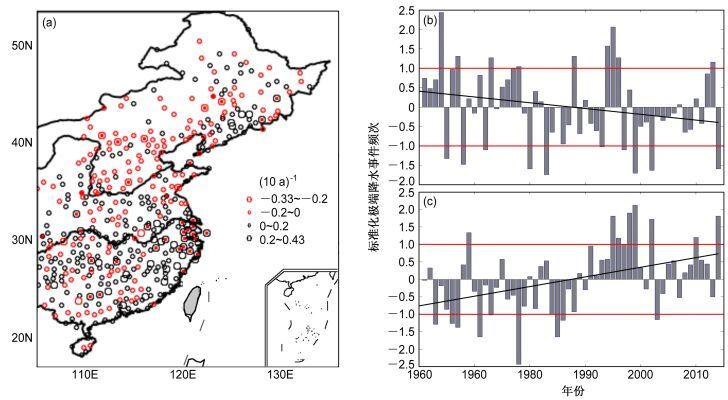
|
图 1 (a)中国东部夏季极端降水事件频次变化趋势;(b)华北地区和(c)长江中下游地区夏季标准化极端降水事件频次时间变化序列 Fig. 1 (a) Linear tendency rate of extreme precipitation frequency in East China during summer; the time series of normalized extreme precipitation frequency in (b) North China and (c) middle and lower reaches of the Yangtze River |
图 2为夏季长江中下游极端降水频次偏多年和偏少年与气候态的差值场所对应的高低空环流。如图所示,在夏季极端降水频次偏多年时,500 hPa 40°N~50°N广大地区为正距平控制,有利于阻塞高压(以下简称为阻高)的发生、发展,有利于冷空气南下。同时夏季偏多年时500 hPa亚洲中高纬表现出正负的南北向的波列距平,而在偏少年时,中高纬则表现出相反的波列分布。850 hPa风场距平场显示(图 2a和2d),在夏季极端降水频次偏多年时,长江中下游到东海为一个气旋式距平环流,有利于长江中下游极端降水事件的发生。表明长江中下游极端降水频次与西太平洋副热带高压(以下简称西太副高)的关系成正比,这与前人的研究一致(张庆云和郭恒,2014)。北半球副热带高空西风急流是位于对流层中高层具有行星尺度的大气环流系统,它对中、低层系统大气环流异常有着重要的作用,夏季东亚副热带西风急流在30°N~50°N,急流轴位于40°N附近。因此从200 hPa纬向风距平场可以看出,在夏季极端降水频次偏多年时,副热带西风急流偏南,有利于长江中下游极端降水的发生,同时,30°N以北东风气流异常,有利于辐合,30°N以南的地区西风气流异常,有利于辐散。相反,当夏季长江中下游极端降水频次偏少年时,高低空环流场上,基本上呈现出相反的形态。

|
图 2 1961~2014年夏季长江中下游地区极端降水频次偏多年(偏少年)(a、d)850 hPa风场、(b、e)500 hPa高度场和(c、f)200 hPa纬向风场与气候态差值场(距平场)的分布(红色的点代表通过95%置信水平检验):(a、b、c)极端降水频次偏多年;(d、e、f)极端降水频次偏少年 Fig. 2 (a, d) 850-hPa wind anomalies, (b, e) 500-hPa height anomalies, and (c, f) 200-hPa zonal wind anomalies corresponding to increase (decrease) in the frequency of extreme precipitation over the middle and lower reaches of the Yangtze River in summer: (a, b, c) Years with the frequency of extreme precipitation increased; (d, e, f) years with the frequency of extreme precipitation declined. Red dots represent 95% confidence level |
为了更加客观地描述中高纬不同阻塞高压对于极端降水的影响,利用TM90方法计算了夏季不同极端降水频次下500 hPa中高纬阻塞高压的活动频次,图 3表明,夏季长江中下游极端降水频次偏多年与偏少年时,鄂霍次克海地区的阻塞高压存在着较明显的差别,夏季极端降水频次偏多年时,鄂霍次克海地区的阻塞日数达到16 d,而在极端降水频次偏少年时,阻塞日数则在10 d左右,表明夏季长江中下游极端降水频次偏多与鄂霍次克海附近的阻塞日数偏多有关。
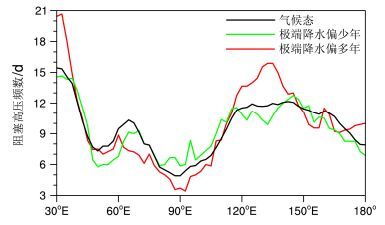
|
图 3 1961~2014年夏季中高纬度地区500 hPa高度场阻塞高压频数 Fig. 3 The frequency of blocking occurrence at 500-hPa geopotential height field in the middle-high latitudes in summer during1961-2014 |
从图 4多年平均的夏季全球整层水汽通量流函数可知,非辐散的水汽通量,反应的是水汽通量沿等压线输送的部分,在全球水汽输送中占主要部分。对全球而言,有3个高值中心:印度洋地区、太平洋地区和大西洋地区。在热带地区,特别是赤道以南地区存在一支向西输送的水汽带,转向北半球,经过印度半岛、中南半岛和南海进入我国。另外来自太平洋地区的水汽输送,也向西输送,经过西太平洋和南海进入中国大陆。整层水汽通量的势函数值较流函数要小,且辐散分量比非辐散量要小,辐散分量经向分量和纬向分量大小一致,而非辐散分量以纬向为主,如图所示,夏季中国东部为势函数的小值区,即对中国东部夏季而言,是一个巨大的水汽汇。
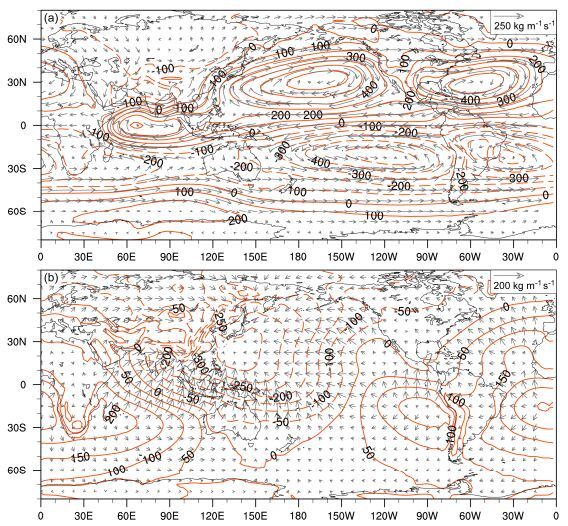
|
图 4 1961~2014年夏季整层(1000~300 hPa)水汽通量输送(a)流函数(等值线,单位:106 kg s-1)和非辐散分量(矢量)以及(b)势函数(等值线,单位:106 kg s-1)和辐散分量(矢量)分布 Fig. 4 (a) Distribution of integrated stream function (contour, units: 106 kg s-1) and the non-divergent component (vector) of water vapor transport, and (b) distribution of integrated potential function (contour, units: 106 kg s-1) and the divergent component (vector) of water vapor transport in summer during 1961-2014 |
图 5为夏季长江中下游地区极端降水频次偏多年和偏少年的水汽通量的流函数和势函数及非辐散分量和辐散分量。从水汽通量流函数来看,极端降水频次偏多年时,长江中下游地区水汽通量流函数距平大于偏少年距平,水汽通量的非辐散分量,一支从西太平洋水汽输送和来自印度地区的水汽输送汇合为一支,另一支来自鄂霍次克海,两支水汽在长江中下游地区汇合,有利于长江中下游极端降水事件的发生,此外,在中国东部有较强向南水汽输送,表明东亚夏季风偏弱(黄荣辉等,2013),偏弱的东亚夏季风,有利于雨带偏南(Zhang et al., 2008),从而有利于长江中下游极端降水事件的发生。偏少年水汽通量的非辐散通量向中国北方地区输送,不利于长江中下游极端降水的发生。对穿越等压线的水汽通量的势函数和辐散分量而言,虽然,偏多年水汽通量势函数距平大于偏少年距平,但是就水汽通量的辐散分量上来看,在偏多年水汽的在长江中下游地区是呈辐合的,而在偏少年则为辐散的,这与水汽通量散度的分布区域基本吻合(图略),表明夏季长江中下游地区在极端降水频次偏多年,水汽辐合输送为极端降水事件提供了充足的水汽条件。
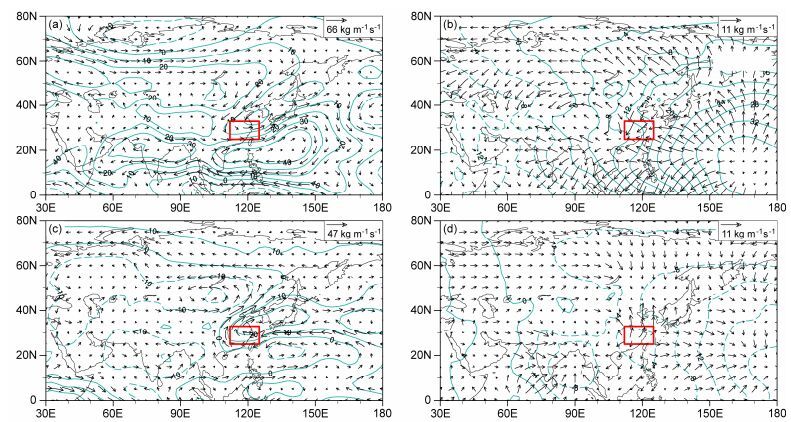
|
图 5 1961~2014年夏季长江中下游极端降水频次偏多年(偏少年)整层(1000~300 hPa)水汽通量输送(a、c)流函数(等值线,单位:106 kg s−1)和非辐散分量(矢量)以及(b、d)势函数(等值线,单位:106 kg s−1)及辐散分量距平分布(图中红框表示长江中下游):(a、b)极端降水频次偏多年;(c、d)极端降水频次偏少年 Fig. 5 (a, c) Anomalous distribution of integrated stream function (contour, units: 106 kg s−1) and the non-divergent component (vector) of water vapor transport, and (b, d) anomalous distribution of integrated potential function (contour, units: 106 kg s−1) and the divergent component (vector) of water vapor transport corresponding to increase (decrease) in the frequency of extreme precipitation during 1961-2014 over the middle and lower reaches of the Yangtze River in summer (the red box indicates the area of the middle and lower reaches of Yangtze River): (a, b) Years with the frequency of extreme precipitation increased; (c, d) years with the frequency of extreme precipitation declined |
波作用通量代表描述波动能量的传播方向,图 6描述的是夏季对流层中、高层波作用通量扣除CUM后的水平分量和扰动流函数分布图,梅世龙和管兆勇(2008, 2009)等指出,斜压波包向下游传播时,其带来的扰动能量可以为当地暴雨的发生发展提供必要的能量集聚。对夏季长江中下游地区极端降水频次偏多(少)年的波作用通量进行分析,极端降水频次偏多年时,500 hPa和200 hPa波作用通量呈西北东南向的输入长江中下游地区,有利于该地区能量的集聚,从而有利于极端降水事件的发生。当极端降水频次偏少年时,波作用通量在长江中下游地区呈现向东输送,不利于能量在长江中下游地区集聚,从而不利于极端降水事件的发生。同时,夏季长江中下游地区极端降水频次多年,扰动流函数多为正值区,有利于扰动在该地区的发展和维持。
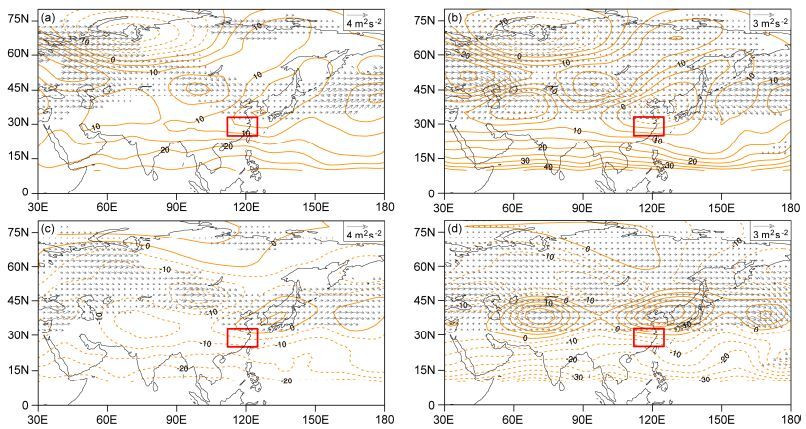
|
图 6 1961~2014年夏季长江中下游极端降水频次偏多年(偏少年)对流层中上层(a、c)500 hPa、(b、d)200 hPa扰动流函数(等值线,单位:105m2s)和波作用通量(矢量):(a、b)极端降水频次偏多年;(c、d)极端降水频次偏少年 Fig. 6 Composites of the wave-activity flux (vector) and quasi-geostrophic steam function (contour, units: 105 m2s) at (a, c) 500 hPa and (b, d) 200 hPa corresponding to increase (decrease) in the frequency extreme precipitation during 1961-2014 over the middle and lower reaches of the Yangtze River in summer: (a, b) Years with the frequency of extreme precipitation increased; (c, d) years with the frequency of extreme precipitation declined |
图 7为华北地区夏季极端降水频次偏多年和偏少年高低空环流。在极端降水频次偏多年,850 hPa风场距平黄海为一个反气旋距平环流,华北地区为偏南风距平环流,表明东亚夏季风偏强(Wang et al., 2008)。500 hPa中高纬呈现出“+”“-”“+”的西北东南向的分布,日本海地区为正距平分布,贝加尔湖和蒙古附近为负距平,华北地区东高西低,低槽东移易受阻,从而有利于华北地区极端降水的发生,西太副高偏北。对流层高层200 hPa副热带西风急流中心在45°N左右,较常年偏北偏强,高层的西风急流有利于中层西太副高的西伸和北抬,这样的高低空环流异常配合,有利于华北地区极端降水多发。极端降水频次偏少年时,850 hPa风场距平为一支偏北距平气流向中国南方地区输送,500 hPa呈现出“-”“+”“-”的西北东南向的分布,此时200 hPa上的西风急偏南,这样的高低空环流不利于华北地区极端降水的发生。
5.2 水汽输送异常分析图 8华北地区夏季极端降水频次偏多(少)年整层水汽通量的流函数和势函数距平场,在极端降水频次偏多年时,华北地区处于水汽通量流函数的正距平区,有一支较强向北的水汽输送,此时表明东亚夏季风偏强。从非辐散分量距平场可得,自赤道向西输送的正的水汽距平,通过西太平洋地区向中国华北地区输送水汽,从而有利于极端降水事件的发生。势函数和辐散分量场,华北地区极端降水频次偏多(少)年的气候场均显示,中国东部地区为水汽汇地区,但在极端降水频次偏多年,辐散的水汽通量距平来呈东北向向华北地区辐合,这意味着更多的水汽将会汇集到华北地区,且对极端降水频次偏少年而言,偏多年呈相对辐合状态。整层水汽通量散度场(图略)也显示在极端降水频次偏多年,华北地区位于水汽通量的辐合区。这表明区域性极端降水的发生与大范围的水汽输送和水汽辐合是相联系的。而偏少年的情况则刚好相反,这里就不赘述。
5.3 波作用通量分析
同样,对夏季华北地区的波动能量传播进行分析,如图所示,在极端降水频次偏多年,500 hPa和200 hPa波作用通量向华北地区集聚,同时扰动流函数为正值,这种扰动有利于能量的集聚,为华北极端降水事件的发生集聚能量,极端降水频次偏少年,500 hPa波动能量的传播主要是向东传播,200 hPa波动能量则在华北地区的西北角形成绕流,不利于能量的汇集。
上文两个地区的分析结果表明,当长江中下游地区极端降水频次偏多时,水汽输送场和850 hPa风场表现出东亚夏季风偏弱,且此时急流位置偏南,而当华北地区极端降水频次偏多时,大气环流场和水汽输送表现为东亚夏季风偏强,且此时急流位置偏北。况雪源和张耀存(2006)通过研究发现当东亚夏季风偏强时,东亚副热带西风急流偏北,反之,当东亚夏季风偏弱时,东亚副热带西风急流偏南。这表明东亚夏季风和急流位置的变化对中国东部极端降水频次的变化有着重要的影响。
6 结果与讨论本文主要在分析中国东部夏季极端降水频次分布特征的基础上,集中讨论了中国东部(长江中下游地区和华北地区)在夏季极端降水频次偏多(少)下环流的年际变化特征,得到以下结论:
(1)中国东部夏季极端降水事件频次呈现长江及其以南为增加趋势,其中长江中下游地区呈现全区一致的增加趋势,中国北方地区减少,其中华北地区基本呈全区一致的减少。
(2)对长江中下游地区而言(图 10a),在极端降水频次偏多年,整层的水汽输送距平场表明东亚夏季风偏弱,有利于更多的水汽输送到长江中下游地区,500 hPa鄂霍次克海阻高持续日数增多,有利于冷空气南下,200 hPa东亚副热带急流偏南,且30°N以南偏西风异常有利于辐散,从而导致我国长江中下游地区极端降水频次偏多,斜压波包的能量传播也为极端降水事件的发生集聚了能量。而在极端降水频次偏少年则相反。
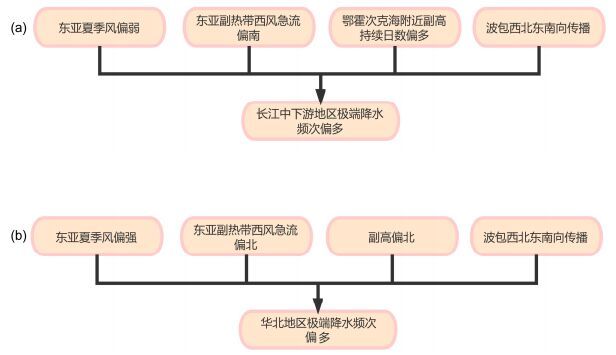
|
图 10 (a)长江中下游地区和(b)华北地区夏季极端降水异常分析机理示意图 Fig. 10 The mechanism of extreme precipitation anomaly analysis in (a) the middle and lower reaches of the Yangtze River and (b) North China |
(3)对华北地区而言(图 10b),华北地区在极端降水事件频次偏多年时,整层水汽距平场和850 hPa风场距平场上东亚夏季风偏强,有利于更多的水汽输送到我国华北地区,500 hPa中高纬大陆为负距平,日本海为正距平,华北地区东高西低,200 hPa偏北的东亚副热带西风急流有利于副高的北抬,从而有利于我国华北地区极端降水的频发,而能量的传播也为极端降水事件的发生集聚能量。在极端降水频次偏少年则相反。
近年来有关极端降水的研究取得不少进展,研究结果多侧重于极端事件的长期变化趋势,及小范围区域的单站现象研究(管兆勇和任国玉,2012),本文主要集中在中国东部极端降水频次时空变化一致的两个区域,着重大气内部的动力角度讨论了夏季中国东部极端降水频次异常情况下大气环流的变化。同时从能量输送的角度简单分析了极端降水所需的能量输送。然而,对于大气的热力状况及其他外强迫对于我国东部夏季极端降水事件同样具有重要的影响,这值得我们进行进一步的深入研究。
| [] | Alexander L V, Zhang X, Peterson T C, et al. 2006. Global observed changes in daily climate extremes of temperature and precipitation[J]. J. Geophys. Res., 111(D5). DOI:10.1029/2005JD006290 |
| [] | Bonsal B R, Zhang X, Vincent L A, et al. 2001. Characteristics of daily and extreme temperatures over Canada[J]. J. Climate, 14(9): 1959–1976. DOI:10.1175/1520-0442(2001)014<1959:CODAET>2.0.CO;2 |
| [] | Bracken C, Rajagopalan B, Alexander M A, et al. 2015. Spatial variability of seasonal extreme precipitation in the western United States[J]. J. Geophys. Res., 120(10): 4522–4533. DOI:10.1002/2015JD023205 |
| [] | 陈海山, 范苏丹, 张新华. 2009. 中国近50a极端降水事件变化特征的季节性差异[J]. 大气科学学报, 32(6): 744–751. Chen Haishan, Fan Sudan, Zhang Xinhua. 2009. Seasonal differences of variation characteristics of extreme precipitation events over China in the last 50 years[J]. Transactions of Atmospheric Sciences, 32(6): 744–751. DOI:10.3969/j.issn.1674-7097.2009.06.003 |
| [] | Chen T C. 1985. Global water vapor flux and maintenance during FGGE[J]. Mon. Wea. Rev., 113(10): 1801–1819. DOI:10.1175/1520-0493(1985)113<1801:GWVFAM>2.0.CO;2 |
| [] | 丁一汇, 刘月贞. 1986. 7507号台风中水汽收支的研究[J]. 海洋学报, 8(3): 291–301. Ding Yihui, Liu Yuezhen. 1986. Study of water vapor budget on typhoon 7507[J]. ActaOceanologicaSinica, 8(3): 291–301. |
| [] | 董蕾, 张明军, 王圣杰, 等. 2014. 基于格点数据的西北干旱区极端降水事件分析[J]. 自然资源学报, 29(12): 2048–2057. Dong Lei, Zhang Mingjun, Wang Shengjie, et al. 2014. Extreme precipitation events in arid areas in Northwest China based on gridded data[J]. Journal of Natural Resources, 29(12): 2048–2057. DOI:10.11849/zrzyxb.2014.12.006 |
| [] | Dong Q, Chen X, Chen T X. 2011. Characteristics and changes of extreme precipitation in the Yellow-Huaihe and Yangtze-Huaihe rivers basins, China[J]. J. Climate, 24(14): 3781–3795. DOI:10.1175/2010JCLI3653.1 |
| [] | Duan W L, He B, Takara K, et al. 2015. Changes of precipitation amounts and extremes over Japan between 1901 and 2012 and their connection to climate indices[J]. Climate Dyn., 45(7-8): 2273–2292. DOI:10.1007/s00382-015-2778-8 |
| [] | 管兆勇, 任国玉. 2012. 中国区域极端天气气候事件变化研究[M]. 北京: 气象出版社: 347pp. Guan Zhaoyong, Ren Guoyu. 2012. On Variationsof Weather and Climate Extremes in China[M]. Beijing: China Meteorological Press: 347pp. |
| [] | 黄荣辉, 刘永, 冯涛. 2013. 20世纪90年代末中国东部夏季降水和环流的年代际变化特征及其内动力成因[J]. 科学通报, 58(12): 1339–1349. Huang Ronghui, Liu Yong, Feng Tao. 2013. Interdecadal change of summer precipitation over Eastern China around the late-1990s and associated circulation anomalies, internal dynamical causes[J]. Chinese Science Bulletin, 58(12): 1339–1349. DOI:10.1007/s11434-012-5545-9 |
| [] | IPCC. 2001. Climate change 2001: The science of climate change[C]//Contribution of Working Group I to the Third Assessment Report of the Intergovernmental Panel on Climate Change. Houghton J T, Ding Y, Griggs D J, et al, Eds. Cambridge, UK and New York, USA: Cambridge University Press, 156-159. |
| [] | IPCC. 2007. Climate change 2007: The physical science basis[C]//Contribution of Working Group I to the Fourth Assessment Report of the Intergovernmental Panel on Climate Change. Solomon S, Qin D, Manning M, et al, Eds. Cambridge, Cambridge University Press, 710-719. |
| [] | Jun T, Munasinghe L, Rind D H. 2015. A new metric for Indian monsoon rainfall extremes[J]. J. Climate, 28(7): 2842–2855. DOI:10.1175/JCLI-D-13-00764.1 |
| [] | Kalnay E, Kanamitsu M, Kistler R, et al. 1996. The NCEP/NCAR 40-year reanalysis project[J]. Bull. Amer. Meteor. Soc., 77(3): 437–471. DOI:10.1175/1520-0477(1996)077<0437:TNYRP>2.0.CO;2 |
| [] | 柯丹, 管兆勇. 2014. 华中地区夏季区域性极端日降水事件变化特征及环流异常[J]. 气象学报, 72(3): 478–493. Ke Dan, Guan Zhaoyong. 2014. Regional mean daily precipitation extremes over central China during boreal summer and its relation with the anomalous circulation patterns[J]. Acta Geographica Sinica, 72(3): 478–493. DOI:10.11676/qxxb2014.037 |
| [] | 况雪源, 张耀存. 2006. 东亚副热带西风急流位置异常对长江中下游夏季降水的影响[J]. 高原气象, 25(3): 382–389. Kuang Xueyuan, Zhang Yaocun. 2006. Impact of the position abnormalities of East Asian subtropical westerly jet on summer precipitation in middle-lower reaches of Yangtze River[J]. Plateau Meteorology, 25(3): 382–389. DOI:10.3321/j.issn.1000-0534-2006.03.004 |
| [] | 李威, 翟盘茂. 2009. 中国极端强降水日数与ENSO的关系[J]. 气候变化研究进展, 5(6): 336–342. Li Wei, Zhai Panmao. 2009. Relationship between ENSO and frequency of extreme precipitation days in China[J]. Advances in Climate Change Research, 5(6): 336–342. DOI:10.3969/j.issn.1673-1719.2009.06.004 |
| [] | Mao R, Gong D Y, Yang J, et al. 2011. Linkage between the Arctic Oscillation and winter extreme precipitation over central-southern China[J]. Climate Research, 50(2-3): 187–201. DOI:10.3354/cr01041 |
| [] | 梅士龙, 管兆勇. 2008. 对流层上层斜压波包活动与2003年江淮流域梅雨的关系[J]. 大气科学, 32(6): 1333–1340. Mei Shilong, Guan Zhaoyong. 2008. Activities of baroclinic wave packets in the upper troposphere related to Meiyu of 2003 in the Yangtze River and Huaihe River valley[J]. Chinese Journal of Atmospheric Sciences, 32(6): 1333–1340. DOI:10.3878/j.issn.1006-9895.2008.06.08 |
| [] | 梅士龙, 管兆勇. 2009. 1998年长江中下游梅雨期间对流层上层斜压波包的传播[J]. 热带气象学报, 25(3): 300–306. Mei Shilong, Guan Zhaoyong. 2009. Propagation of baroclinic wave packets in upper troposphere during the Meiyu period of 1998 over middle and lower reaches of Yangtze River valley[J]. Journal of Tropical Meteorology, 25(3): 300–306. DOI:10.3969/j.issn.1004-4965.2009.03.007 |
| [] | 任正果, 张明军, 王圣杰, 等. 2014. 1961-2011年中国南方地区极端降水事件变化[J]. 地理学报, 69(5): 640–649. Ren Zhengguo, Zhang Mingjun, Wang Shengjie, et al. 2014. Changes in precipitation extremes in South China during 1961-2011[J]. Acta Geographica Sinica, 69(5): 640–649. DOI:10.11821/dlxb201405007 |
| [] | 施能, 黄先香, 杨扬. 2003. 1948~2000年全球陆地年降水量场趋势变化的时、空特征[J]. 大气科学, 27(6): 971–982. Shi Neng, Huang Xianxiang, Yang Yang. 2003. Spatiotemporal features of the trend variation of global land annual rainfall fields from 1948-2000[J]. Chinese Journal of Atmospheric Sciences, 27(6): 971–982. DOI:10.3878/j.issn.1006-9895.2003.06.02 |
| [] | Takaya K, Nakamura H. 2001. A formulation of a phase-independent wave-activity flux for stationary and migratory quasi geostrophic eddies on a zonally varying basic flow[J]. J. Atmos. Sci., 58(6): 608–627. DOI:10.1175/1520-0469(2001)058<0608:AFOAPI>2.0.CO;2 |
| [] | Tibaldi S, Molteni F. 1990. On the operational predictability of blocking[J]. Tellus A, 42(3): 343–365. DOI:10.3402/tellusa.v42i3.11882 |
| [] | Wang B, Wu Z W, Li J P, et al. 2008. How to measure the strength of the East Asian summer monsoon[J]. J. Climate, 21(17): 4449–4463. DOI:10.1175/2008JCLI2183.1 |
| [] | Wang Y Q, Zhou L. 2005. Observed trends in extreme precipitation events in China during 1961-2001 and the associated changes in large-scale circulation[J]. Geophys. Res. Lett., 32(9): L09707. DOI:10.1029/2005GL022574 |
| [] | 杨金虎, 江志红, 王鹏翔, 等. 2008. 中国年极端降水事件的时空分布特征[J]. 气候与环境研究, 13(1): 75–83. Yang Jinhu, Jiang Zhihong, Wang Pengxiang, et al. 2008. Temporal and spatial characteristic of extreme precipitation event in China[J]. Climatic and Environmental Research, 13(1): 75–83. DOI:10.3878/j.issn.1006-9585.2008.01.10 |
| [] | 杨溯, 李庆祥. 2014. 中国降水量序列均一性分析方法及数据集更新完善[J]. 气候变化研究进展, 10(4): 276–281. Yang Su, Li Qingxiang. 2014. Improvement in homogeneity analysis method and update of China precipitation data[J]. Progressus Inquisitionesde Mutatione Climatis, 10(4): 276–281. DOI:10.3969/j.issn.1673-1719.2014.04.008 |
| [] | 翟盘茂, 潘晓华. 2003. 中国北方近50年温度和降水极端事件变化[J]. 地理学报, 58(S): 1–10. Zhai Panmao, Pan Xiaohua. 2003. Change in extreme temperature and precipitation over northern China during the second half of the 20th century[J]. Acta Geographica Sinica, 58(S): 1–10. DOI:10.3321/j.issn:0375-5444.2003.z1.001 |
| [] | 翟盘茂, 章国材. 2004. 气候变化与气象灾害[J]. 科技导报, 22(7): 11–14. Zhai Panmao, Zhang Guocai. 2004. Climate change and meteorological disasters[J]. Science and Technology Review, 22(7): 11–14. DOI:10.3321/j.issn:1000-7857.2004.07.004 |
| [] | 翟盘茂, 王萃萃, 李威. 2007. 极端降水事件变化的观测研究[J]. 气候变化研究进展, 3(3): 144–148. Zhai Panmao, Wang Cuicui, Li Wei. 2007. A review on study of change in precipitation extremes[J]. Advances in Climate Change Research, 3(3): 144–148. DOI:10.3969/j.issn.1673-1719.2007.03.004 |
| [] | Zhai P M, Zhang X B, Wan H, et al. 2005. Trends in total precipitation and frequency of daily precipitation extremes over China[J]. J. Climate, 18(7): 1096–1108. DOI:10.1175/JCLI-3318.1 |
| [] | Zhang L, Sielmann F, Fraedrich K, et al. 2015. Variability of winter extreme precipitation in Southeast China:Contributions of SST anomalies[J]. Climate Dyn., 45(9-10): 2557–2570. DOI:10.1007/s00382-015-2492-6 |
| [] | Zhang Q, Xu C Y, Zhang Z X, et al. 2008. Spatial and temporal variability of precipitation maxima during 1960-2005 in the Yangtze River basin and possible association with large-scale circulation[J]. J. Hydrol., 353(3-4): 215–227. DOI:10.1016/j.jhydrol.2007.11.023 |
| [] | 张庆云, 郭恒. 2014. 夏季长江淮河流域异常降水事件环流差异及机理研究[J]. 大气科学, 38(4): 656–669. Zhang Qingyun, Guo Heng. 2014. Circulation differences in anomalous rainfall over the Yangtze River and Huaihe River valleys in summer[J]. Chinese Journal of Atmospheric Sciences, 38(4): 656–669. DOI:10.3878/j.issn.1006-9895.1402.13240 |
| [] | 赵俊虎, 周杰, 叶天舒, 等. 2015. 2013年夏季中国北涝南旱环境场及异常成因分析[J]. 气象科技进展, 5(5): 14–23. Zhao Junhu, Zhou Jie, Ye Tianshu, et al. 2015. Preliminary studies on the environment field and cause of northern flood and southern drought during the summer of 2013 in China[J]. Advances in Meteorological Science and Technology, 5(5): 14–23. DOI:10.3969/j.issn.2095-1973.2015.05.002 |
 2018, Vol. 23
2018, Vol. 23



